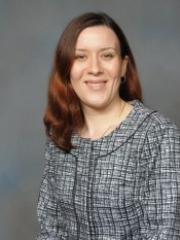
Anna Erickson is an assistant professor in Nuclear and Radiological Engineering at the Georgia Institute of Technology. She was a DOE National Nuclear Security and Administration Stewardship Science Graduate Fellowship recipient from 2008 to 2011. She served an internship, a practicum and a postdoctoral research fellowship at Lawrence Livermore National Laboratory.
Why are you interested in nuclear science?
The fascinating thing about nuclear science is it depends on both physics and mathematics, so you have to be good at both. We also use basic physics to create practical things, like nuclear reactors or medical devices or to enforce nuclear security at our borders. This practical application of fundamental physics drew me to the field.
What career did you foresee when you started graduate school?
I thought I would get a job at a national laboratory, and I interned at Argonne three times as an undergraduate. I focused on fast reactors and moved to MIT to complete my graduate degree. I loved the technology, but I was focusing on what I call paper reactors: In the U.S. at that time there was little chance the fast reactor programs would restart or that the plans themselves would be built.
I turned to something more hands-on – something I could build and focus on the actual physics of the research – and that was nuclear security and detection systems. That led me to internships at Lawrence Livermore National Laboratory and to the DOE NNSA SSGF.
The last year of my Ph.D., the chair of the mechanical engineering school at Georgia Tech emailed out of the blue asking if I was interested in academia. Livermore already had a spot for me as a postdoc after graduation, but I met with him. He listed reasons to teach that I never considered, especially shaping your research to influence the science but also to create the next generation of scientists. Georgia Tech also was willing to hold the position open while I completed my Livermore postdoc. That persuaded me to join academia. It also helped that the interview happened in February, during the worst snow year in Boston, and it was 75 degrees and sunny in Atlanta.
How did the fellowship influence your career?
Turing to issues of nuclear security, nonproliferation and stockpile stewardship helped me understand that nuclear engineering has a really intricate interplay between nuclear physics, policy and the actual engineering. Spending three years as a fellow also allowed me to meet people with various backgrounds who I’ve continued interacting with past graduation. The program shaped my career and my understanding of nuclear engineering, but also gave me some good friendships and it continues to do so.
Your research revolves around reactor design, especially as it pertains to national security and nuclear nonproliferation. What makes this important?
When I started my career, I focused on the safety aspects of nuclear reactor design. It never entered my mind that there’s a nonproliferation aspect. When I switched to nuclear security, I focused on methods to find nuclear material and keep it from entering the country. People would say that’s a disconnect from reactor design, but it turns out that separating nuclear power from proliferation is wrong.
The importance of my research is that it focuses on nuclear power that is economical, safe, efficient and reliable but also doesn’t contribute to proliferation. The other aspect is understanding how to detect at a port or border any nuclear material from a reactor or enrichment facility. Nonproliferation is a multifaceted problem and just studying one side isn’t enough. That’s why my group focuses on the full picture, from the reactor all the way to identifying that (nuclear) material.
How can the sophisticated detectors you develop stop nuclear proliferation?
One aspect of our research is using detectors for active interrogation. That’s a fancy name for combining an external source of radiation - X-ray or gamma radiation, for example – with a system to either image the material or just find an identify it. We deal with the challenges associated with this active interrogation environment, which tends to have high rates of radiation emission from the source. Transmitting that radiation through objects provides information to confirm the presence of special nuclear material.
What role do you see the DOE NNSA SSGF playing in the nuclear energy arena?
The fellowship invests in human capital needed to understand the physics behind the processes related to the stockpile, but it also has a much broader role. It’s really invested in the fundamental physics of nuclear-related processes, whether it’s fission or fusion. Those fundamental physics are the same regardless of the context. Instrumenting tomorrow’s advanced reactors will require an understanding of coolants, and fuels, changes to the fuel over time, and neutron radiation. Stewardship science addresses a lot of that through a different application.
Stewardship Science, The SSGF Magazine
